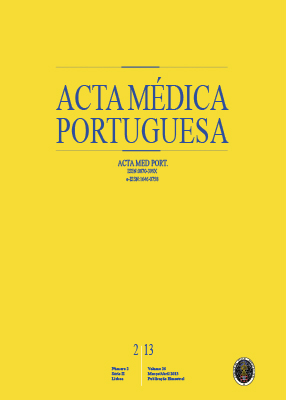Uma Velha Questão numa População Jovem: o Consumo do Álcool nos Adolescentes Escolarizados
DOI:
https://doi.org/10.20344/amp.4106Resumo
Introdução: É principalmente na adolescência que os jovens procuram novas experiências. O consumo de álcool surge neste contexto como uma atitude banalizada e, por vezes, até incitada socialmente, já que o acesso a bebidas alcoólicas é facilitado. Associa-se a comportamentos de risco, com consequências sérias do ponto de vista de saúde pública. O nosso objectivo é caracterizar os padrões de consumo de álcool numa amostra de adolescentes residentes no distrito de Leiria. Material e Métodos: Estudo transversal, descritivo, através de um questionário anónimo aplicado em alunos do distrito de Leiria. Resultados: A amostra final foi de 405 indivíduos, 56% do sexo feminino, com idade média de 16,5 ± 1 anos (15 - 18 anos). A maioria (48%) frequentava o 10º ano, 15,4% reprovaram pelo menos uma vez. Noventa por cento dos inquiridos afirmaram ter experimentado bebidas alcoólicas pelo menos uma vez. O primeiro contacto com o álcool ocorreu preferencialmente com amigos (63%), na maioria dos casos por curiosidade (47%). Os resultados apontaram para maiores índices de consumo de cerveja e maior insucesso escolar no género masculino, comparativamente ao género feminino, que apresentava um maior consumo de bebidas brancas. Em ambos os sexos verificou-se uma tendência para o binge drinking. A maioria dos inquiridos (60%) consumia 2 a 3 copos por ocasião mas cerca de 30% dos rapazes afirmaram consumir mais de quatro copos por ocasião (7% até ficarem embriagados), tendência que não se verificou nas raparigas. A maioria dos consumos efectuou-se nos bares e discotecas (60%). Constatou-se que 41% dos inquiridos saíam à noite, e 70% ingeriam bebidas alcoólicas; 66% começaram a sair à noite entre os 13 e os 15 anos de idade e 9% já tinham experimentado drogas pelo menos uma vez. Os jovens estão mal informados quanto ao consumo do álcool: 20% achavam que as bebidas alcoólicas podem matar a sede, 34% acreditavam que abrem o apetite, 15,4% defendiam que não havia problemas em conduzir desde que não se bebesse demasiado. Conclusão: O padrão de consumo de álcool nestes adolescentes é preocupante e com características semelhantes às descritas noutros estudos europeus. É necessária uma estratégia urgente para mudar este velho paradigma.
Downloads
Downloads
Como Citar
Edição
Secção
Licença
Todos os artigos publicados na AMP são de acesso aberto e cumprem os requisitos das agências de financiamento ou instituições académicas. Relativamente à utilização por terceiros a AMP rege-se pelos termos da licença Creative Commons ‘Atribuição – Uso Não-Comercial – (CC-BY-NC)’.
É da responsabilidade do autor obter permissão para reproduzir figuras, tabelas, etc., de outras publicações. Após a aceitação de um artigo, os autores serão convidados a preencher uma “Declaração de Responsabilidade Autoral e Partilha de Direitos de Autor “(http://www.actamedicaportuguesa.com/info/AMP-NormasPublicacao.pdf) e a “Declaração de Potenciais Conflitos de Interesse” (http://www.icmje.org/conflicts-of-interest) do ICMJE. Será enviado um e-mail ao autor correspondente, confirmando a receção do manuscrito.
Após a publicação, os autores ficam autorizados a disponibilizar os seus artigos em repositórios das suas instituições de origem, desde que mencionem sempre onde foram publicados e de acordo com a licença Creative Commons









